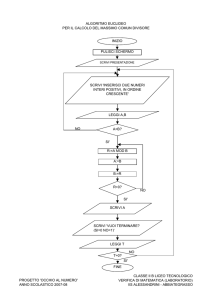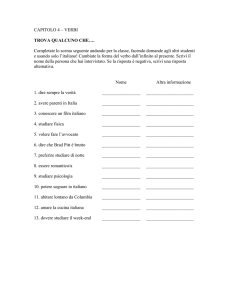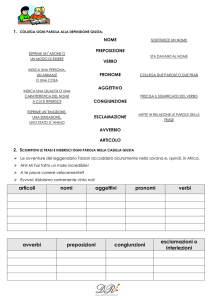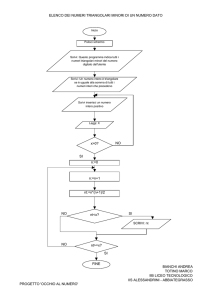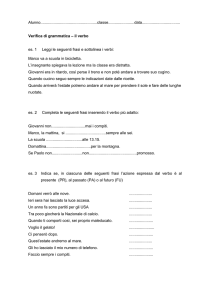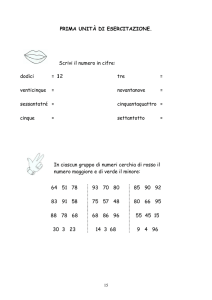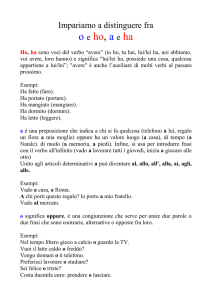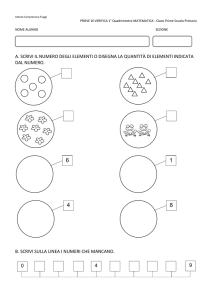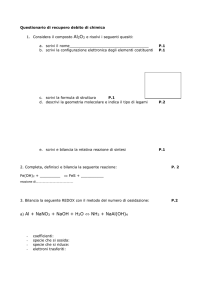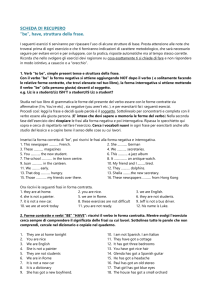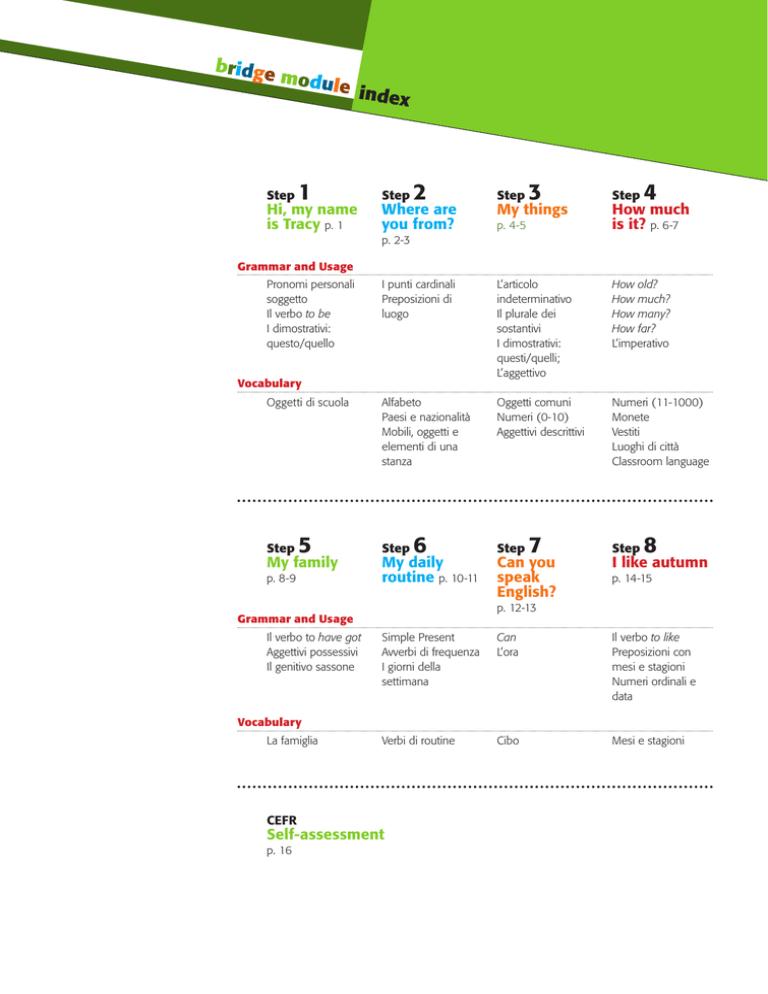
bridge
modul
Step
e ind
ex
1
Hi, my name
is Tracy p. 1
A
Step
2
Where are
you from?
Step
3
My things
p. 4-5
Step
4
How much
is it? p. 6-7
p. 2-3
Grammar and Usage
Pronomi personali
soggetto
Il verbo to be
I dimostrativi:
questo/quello
I punti cardinali
Preposizioni di
luogo
L’articolo
indeterminativo
Il plurale dei
sostantivi
I dimostrativi:
questi/quelli;
L’aggettivo
How old?
How much?
How many?
How far?
L’imperativo
Alfabeto
Paesi e nazionalità
Mobili, oggetti e
elementi di una
stanza
Oggetti comuni
Numeri (0-10)
Aggettivi descrittivi
Numeri (11-1000)
Monete
Vestiti
Luoghi di città
Classroom language
Vocabulary
Oggetti di scuola
Step
5
My family
p. 8-9
Step
6
My daily
routine p. 10-11
7
Can you
speak
English?
Step
8
I like autumn
p. 14-15
p. 12-13
Grammar and Usage
Il verbo to have got
Aggettivi possessivi
Il genitivo sassone
Step
Simple Present
Avverbi di frequenza
I giorni della
settimana
Can
L’ora
Il verbo to like
Preposizioni con
mesi e stagioni
Numeri ordinali e
data
Verbi di routine
Cibo
Mesi e stagioni
Vocabulary
La famiglia
CEFR
Self-assessment
p. 16
step
1
Hi, my name is Tracy
1. Ascolta [
1:1] e completa gli spazi con
le parole mancanti.
bridge module
3. Usa le immagini per formulare domande e
risposte.
Example 1. Who is he? He is Russell Crowe.
This is my . . . . . . .
His name is . . . . . .
Hi. My name's
Tracy. . . . . . . 'm a
new . . . . . . in this
school.
Hi, . . . . . . . . . . . . .
to meet
you.
Hi,
. . . . . . . . . . . . . to
meet you.
This is my twin
......, ...... .
. . . . . . is a . . . . . . ,
too.
Are . . . . . . happy
to be here?
Yes, . . . . . .
......
4. Completa le frasi con la forma corretta
del verbo essere e il pronome personale
adeguato.
onali
pronomi pseors
ggetto
Singolare
Plurale
I
you
he / she / it
we
you
they
Grammar
1.
2.
3.
4.
5.
6.
Are Andy and Tracy friends? Yes, they are.
. . . . . . . . . . . . . . . . . . . . great to be back at school.
. . . . . . . . . . . . . . . . . . . . Italian? No, she . . . . . . . . . . . . . . . . . . . . .
Hi, . . . . . . . . . . . . . . . . . . . . Katie.
. . . . . . . . . . . . . . . . . . . . at school? Yes, I . . . . . . . . . . .
. . . . . . . . . . . . . . . . . . . . a book? No, . . . . . . . . . . . . . . . . . . . . . . . . . . . . . . . It . . . . . . . . . . a pen.
tivi:
i dimostra
llo
u
questo / q e
this
Grammar
that
2. Completa le frasi con il pronome
personale soggetto appropriato.
1.
2.
3.
4.
5.
6.
7.
She is a student. (Tracy)
. . . . . . . . . . are sisters. (Katie and I)
Is . . . . . . . . . . American? (Homer Simpson)
. . . . . . . . . . are not an English band. (Tokio Hotel)
. . . . . . . . . . are friends. (Andy and you)
. . . . . . . . . . is not an English teacher. (Maria)
. . . . . . . . . . is a good film. (Lord of the Rings)
il verbo to be
5. Scrivi this o that accanto alle parole.
Example a. that school
Grammar
Affermativa Interrogativa Negativa
I am (‘m)
you are (‘re)
he/she/it is (‘s)
we are (‘re)
you are (‘re)
they are (‘re)
am I
are you
is he/she/it
are we
are you
are they
I am not
you are not (aren’t)
he/she/it is not (isn’t)
we are not (aren’t)
you are not (aren’t)
they are not (aren’t)
a
.......
school
b
.......
blackboard
c
.......
pencil
d
.......
desk
e
.......
computer
f
.......
book
one
1
step
2
1. Ascolta [
dell’alfabeto.
Where are you from?
4. Osserva le illustrazioni e scrivi una frase
1:2] e ripeti le lettere
su ciascuno dei luoghi indicati.
1.
Where is Naples? It is in the South of Italy.
Naples
London
Italy
2. Ascolta [
e
At thel
trav t’s
agen
1.
2.
3.
4.
United Kingdom
1:3] e scrivi le parole che senti.
5.
6.
7.
8.
....................
....................
....................
....................
Paris
....................
....................
Sidney
....................
....................
France
Australia
Rio de Janeiro
Brazil
San Francisco
California
5. Collega il nome del paese con il
corrispondente aggettivo di nazionalità.
Country
Britain
Spain
France
Germany
Japan
Switzerland
Italy
Brazil
3. Ascolta [
1:4] e completa la tabella
con le informazioni mancanti.
Man
Woman
Surname
First name
Home town
Nationality
French
Italian
Japanese
Swiss
Brazilian
British
German
Spanish
6. Ascolta [
1:5] il dialogo e parla di paesi
e nazionalità con il tuo compagno seguendo
il modello.
Nationality
Job
ali
i punti cardin
Where is Glasgow?
It is in the south of Scotland.
Usage
north
west
east
south
2
two
A:
B:
A:
B:
A:
B:
A:
B:
Are you Australian?
No, I am not.
What nationality are you?
I’m Spanish.
Where are you from in Spain?
I’m from Madrid.
Where is Madrid?
It’s in the north of Spain.
bridge module
preposizioni
7. Scopri da quali lingue derivano le seguenti
parole.
di luogo
Grammar
in in / a R The sofa is in the sitting room.
at a / in R The cat is at the door.
on su / sopra (con contatto) R The picture is on the wall.
near vicino a R The door is near the window.
disco
boss
karate
Glossary: La stanza
ceiling
wall
barbecue
kindergarten
door
window
corner
anorak
floor
1.
2.
3.
Eskimo . . . . . . . . . . . . . . . . . . . . . . . . . . . . . . . . .
French . . . . . . . . . . . . . . . . . . . . . . . . . . . . . . . . . .
German . . . . . . . . . . . . . . . . . . . . . . . . . . . . . . .
4.
5.
6.
Dutch . . . . . . . . . . . . . . . . . . . . . . . . . . . . . . . . . . . .
Japanese . . . . . . . . . . . . . . . . . . . . . . . . . . . . .
Spanish . . . . . . . . . . . . . . . . . . . . . . . . . . . . . . . .
8. Scrivi correttamente queste parole.
9. Osserva il disegno e completa le frasi
con la parola e la preposizione corretta.
1.
2.
3.
4.
5.
6.
a ATBEL
The . . . . . . . . . .
The . . . . . . . . . .
The . . . . . . . . . .
The . . . . . . . . . .
The . . . . . . . . . .
The . . . . . . . . . .
are . . . . . . . . . . the window.
is . . . . . . . . . . the wardrobe.
is . . . . . . . . . . the corner.
are . . . . . . . . . . the shelf.
is . . . . . . . . . . the desk.
is . . . . . . . . . . the floor.
b RUTCAINS
c MLAP
d RIHAC
f KEBNALT
e FHSEL
i DBE
g PATRCE
h DWAREBOR
three
3
step
3
My things
eterminativo
l’articolo ind
a book
Grammar
an apple
il plurale dei
sostantivi
Grammar
Sostantivo + s
egg R eggs
1. Guarda la figura. Quante cose riesci ad
identificare?
1. newspaper | 2. orange | 3. bag | 4. umbrella | 5. sock |
6. botttle | 7. football | 8. laptop | 9. pair of trainers
Eccezioni in -es
I sostantivi terminanti in -s, -ss, -ch, -sh, -o, -x, -z
aggiungono -es.
bus R buses
glass R glasses
watch R watches
brush R brushes
tomato R tomatoes
box R boxes
waltz R waltzes
Eccezioni in -ies
I sostantivi terminanti in -y preceduta da consonante
perdono -y e aggiungono -ies.
lady R ladies
Plurali irregolari
Ecco alcuni sostantivi con forme diverse al singolare
e al plurale.
man R men
woman R women
child R children
foot R feet
4. Scrivi il plurale.
2. Ascolta [
3. Ascolta [
telefono.
1.
2.
3.
1:6] i numeri e ripeti.
a key
keys
b glass
c brush
d diary
e foot
f shirt
g child
h watch
1:7] e scrivi i numeri di
....................................................................................................................
....................................................................................................................
....................................................................................................................
4
four
bridge module
l’aggettivo
5. Ascolta [
1:8] la descrizione del
contenuto dalla valigia di Sam e trova le
differenze con la valigia nella figura.
Grammar
L’aggettivo è invariabile e precede il nome a cui si
riferisce. R a cheap dress, two cheap dresses
8. Abbina gli aggettivi agli opposti.
old
pretty
long
high
fast
dirty
short
slow
clean
ugly
young
low
9. Scrivi una frase con un aggettivo per
ciascuna immagine
Example a. The shoes are clean.
i:
i dimostrautievlli
questi / q
these
a shoes
b mountain
c road
d man
e car
f actress
Grammar
those
10. Trasforma le frasi al plurale
apportando le modifiche necessarie.
6. Completa le frasi con this o these.
1.
2.
3.
4.
5.
is my brother Patrick.
is a nice story.
. . . . . . . . . . are smart shoes.
Are . . . . . . . . . . books for me?
. . . . . . . . . . exercises are difficult.
..........
..........
7. Completa le frasi con that o those.
1.
2.
3.
4.
5.
is my car.
. . . . . . . . . . books are on the shelf.
Are . . . . . . . . . . children kind?
Is . . . . . . . . . . flat large?
Who are . . . . . . . . . . men?
..........
1.
2.
3.
4.
5.
6.
7.
8.
That cat is on the chair. Those cats are on the chair.
That jacket is old.
This is a pretty girl.
That is an Italian dish.
This is an English dictionary.
This watch is on the table.
That actress is famous.
This is an interesting atlas.
11. Correggi gli errori.
1.
2.
3.
4.
5.
6.
Those womens are English.
Excuse me, are this the new students?
These two childs are brothers.
Those universitys are famous.
These are long foots.
Hi, this are my friend Sally.
five
5
step
4
1. Ascolta [
e ripeti.
How much is it?
1:9]. Scrivi i numeri mancanti
11 eleven
20 twenty
21 twenty-one
12 . . . . . . . . . .
30 . . . . . . . . . .
34 . . . . . . . . . .
13 thirteen
40 . . . . . . . . . .
45 . . . . . . . . . .
14 . . . . . . . . . .
50 . . . . . . . . . .
56 . . . . . . . . . .
15 . . . . . . . . . .
60 sixty
67 sixty-seven
16 sixteen
70 . . . . . . . . . .
98 . . . . . . . . . .
17 seventeen
80 eighty
18 . . . . . . . . . .
90 . . . . . . . . . .
102 one hundred
and two
19 . . . . . . . . . .
100 one
hundred
111 . . . . . . . . . .
Glossary: Money
1.
1 pound
1 penny
2.
1 euro
1 cent
3.
1 dollar
1 cent
2 pence
178 . . . . . . . . . .
300 three
hundred
1000 . . . . . . . . . .
ow much??
how old? h
ow farr?
how many? h
3. Scrivi i nomi vicino ai capi di vestiario. Poi
scrivi un dialogo per ogni illustrazione.
skirt | jacket | scarf | blouse | dress | boots
Grammar
b € 25
How old are you? I’m fourteen years old.
How much is a cup of coffee? It’s €1.
How many students are there in the class? There are twentyfive.
How far is the station? It’s 50 metres from the bus stop.
a € 39.50
c € 120
2. Osserva le figure e chiedi l’età. Poi
rispondi alle domande.
d € 47
e € 12.60
f € 68
1.
2.
3.
4.
5.
6.
6
six
How much is the dress? It’s thirty-nine euros and 50 cents.
....................................................................................................................
....................................................................................................................
....................................................................................................................
....................................................................................................................
....................................................................................................................
bridge module
4. Chiedi quanto distano i luoghi e
rispondi.
a 2 km
b 150 m
c 300 m
Supermarket
Newsagent’s
Baker’s
d 11 km
e 20 m
f 5 km
Park
Bookshop
Stadium
1.
2.
3.
4.
5.
6.
disegni.
Write! | Sit down! | Open your book! | Don’t talk! |
Don’t eat during the lesson! | Listen!
............................................................
............................................................
............................................................
............................................................
............................................................
............................................................
How far is the supermarket? It’s 2 kilometres from here.
....................................................................................................................
....................................................................................................................
....................................................................................................................
....................................................................................................................
....................................................................................................................
5. Ascolta [
1:10] e scegli il numero
corretto per ogni dialogo.
1.
2.
3.
4.
5.
6.
6. Abbina le istruzioni date in classe ai
a.
a.
a.
a.
a.
a.
35
555
30
40
8
55
b. 55
b. 500
b. 13
b. 13
b. 18
b. 15
l’imperativo
c.
c.
c.
c.
c.
c.
45
550
40
14
80
50
Grammar
3 L’imperativo si forma con l’infinito senza to.
Listen!
3 L’imperativo negativo si forma con Don’t +
infinito senza to.
Don’t speak Italian in the classroom.
3 L’imperativo della prima persona plurale si forma
con Let’s + infinito senza to.
Let’s read aloud.
7. Abbina le situazioni agli imperativi.
1.
2.
3.
4.
5.
There aren’t good programmes on TV.
I’m thirsty.
I’m free this afternoon.
It’s hot.
It’s his birthday tomorrow.
a.
b.
c.
d.
e.
Let’s drink a glass of coke!
Let’s buy him a present!
Let’s go to the cinema!
Let’s open the window!
Let’s play football!
8. Trasforma i comandi in forma negativa
o positiva.
1.
2.
3.
4.
5.
6.
7.
Close the window. Don’t close the window.
Wake up.
Don’t sit down.
Don’t work in pairs.
Stand up.
Start work.
Don’t look at the book.
seven
7
step
5
1. Ascolta [
My family
1:11] e completa gli spazi con le informazioni mancanti.
Surname . . . . . . . . . . . . . . . . . . . . . . . . . . . . . . . . . . . . . .
..........................................
Anthony
father . . . . . . . . . . . . . . . . . . . . . . . . . .
job . . . . . . . . . . . . . . . . . . . . . . . . . . . . . . .
age . . . . . . . . . . . . . . . . . . . . . . . . . . . . . .
grandmother . . . . . . . . . . . . . . . . . . . . . . . . . . . . . . . . .
age . . . . . . . . . . . . . . . . . . . . . . . . . . . . . . . . . . . . . . . . . . . . . . . . . . . .
age . . . . . . . . . . . . . . . . . . . . . . . . . . . . . . . . . . . . . . . . . . . . . . . . . . . .
. . . . . . . . . . . . . . . . . . . . . . . . . . . . . . . . . . . . . . Catherine
job . . . . . . . . . . . . . . . . . . . . . . . . . . . . . . . . . . . . . . . . . . . . . . . . . . . .
age . . . . . . . . . . . . . . . . . . . . . . . . . . . . . . . . . . . . . . . . . . . . . . . . . . . .
. . . . . . . . . . . . . . . . . . . . . . . . . . Janet
age . . . . . . . . . . . . . . . . . . . . . . . . . . . . . .
..........................
John
job . . . . . . . . . . . . . . . . . . . . . . . . . . . . . . .
aunt . . . . . . . . . . . . . . . . . . . . . . . . . . . . . . . . . . . . . . . . . . . . . . . . . .
job . . . . . . . . . . . . . . . . . . . . . . . . . . . . . . . . . . . . . . . . . . . . . . . . . . . .
their son
............................................................
and
. . . . . . . . . . . . . . . . . . . . . . . . . . . . . . . . . . . . . . . . . . . . . . . . . Beth
my . . . . . . . . . . . . . . . . . . . . . . . . . . . . . . . . . . . . . . . . . . . . . . . . . . . . .
ve got
il verbo to ha
Forma affermativa
3 I/you/we/they have got
3 he/she/it has got
I have got two cousins.
Forma negativa
3 I/you/we/they haven’t got
3 he/she/it hasn’t got
He hasn’t got a sister.
8
eight
Grammar
Karen
twin . . . . . . . . . . . . . . . . . . . . . . . . . . . . .
Josh and . . . . . . . . . . . . . . . . . . .
age . . . . . . . . . . . . . . . . . . . . . . . . . . . . . .
2. Completa le frasi con have got / has
got.
Forma interrogativa
3 have I/you/we/they got
3 has he/she/it got
Have you got a cat?
1.
2.
3.
4.
5.
They . . . . . . . . . . . . . . . . . . . . . . . . . . . . beautiful eyes.
The teacher . . . . . . . . . . . . . . . . . . . . . . . . . . . . a nice class.
The doctors . . . . . . . . . . . . . . . . . . . . . . . . . . . . new patients.
Amy . . . . . . . . . . . . . . . . . . . . . . . . . . . . two children.
The journalist . . . . . . . . . . . . . . . . . . . . . . . . . . . . a laptop.
3. Scrivi domande con have got / has got.
1.
2.
3.
4.
5.
your sister / a new dress?
they / a dog?
you / a beautiful garden?
he / an aunt?
your classroom / two windows?
bridge module
4. Trova l’elemento mancante in ogni figura. 6. Abbina il possessore alla cosa posseduta.
Scrivi frasi seguendo l’esempio.
Scrivi frasi con il genitivo sassone.
headlight | tail | handles | laces | door | mouse
Example This is the girl’s mobile.
The house
hasn’t got a door.
......................................
......................................
......................................
......................................
......................................
......................................
......................................
......................................
......................................
......................................
sessivi
aggettivi pos
I R my
you R your
he / she / it R his / her / its
Grammar
we R our
you R your
they R their
bone
This is my son.
5. Completa le frasi con l’aggettivo
tie
possessivo corretto.
1.
2.
3.
4.
5.
6.
John is my uncle. . . . . . . . . . . job is very interesting.
The twins are in . . . . . . . . . . bedroom.
Josh and David, . . . . . . . . . . books are there.
That’s Katie. What’s . . . . . . . . . . telephone number?
Janet and I are sisters. . . . . . . . . . . parents are from Leeds.
My computer is here, but where is . . . . . . . . . . mouse?
one
genitivo sass
Nome singolare
3 possessore + ‘s
+ cosa posseduta
This is Karen’s diary.
backpack
bowl
Grammar
Nome plurale
3 possessore + ‘
+ cosa posseduta
My parents’ car is blue.
Nome plurale irregolare
3 possessore + ‘s + cosa posseduta
The children’s toys are on the floor.
mobile
car
7. Riscrivi le frasi con il genitivo sassone.
1.
2.
3.
4.
5.
The name of my brother is Bruce.
The aunt of Karen is a journalist.
The car of my parents is in the garage.
Jason is the boyfriend of Beth.
The bicycles of the children are in the garden.
nine
9
step
6
My daily routine
nt tense
Simple Prese
Grammar
3. Abbina un verbo ad ogni immagine.
Poi scrivi 8 frasi per descrivere la routine
quotidiana di Brian.
Forma affermativa
3 pronome soggetto (I, you, we, they) + infinito senza to
3
R I work in London.
pronome soggetto (he, she, it) + infinito senza to + s
R He works in London.
y Se il verbo termina in -s, -ss, -x, -sh, -ch, -o, si
aggiunge la desinenza -es all’infinito senza to.
R She goes to school every day.
y Se il verbo termina in -y preceduta da
consonante, si cambia -y in -i e si aggiunge la
desinenza -es all’infinito senza to. R He studies
English on Monday.
. . . . . . to get dressed | . . . . . . to take the bus | . . . . . . to have
breakfast | . . . . . . to wake up | . . . . . . to leave home | . . . . . . to
brush one’s teeth | . . . . . . to get up | . . . . . . to have a shower
1
2
Forma negativa
3 pronome soggetto (I, you, we, they) + don’t + infinito
3
senza to R I don’t have breakfast at 8 o’clock.
pronome soggetto (he, she, it) + doesn’t + infinito
senza to R He doesn’t have breakfast at 8 o’clock.
Forma interrogativa
3 do + pronome soggetto (I, you, we, they) + infinito
3
............................................................
3
............................................................
4
senza to R Do you have breakfast at 8 o’clock?
does + pronome soggetto (he, she, it) + infinito senza
to R Does he have breakfast at 8 o’clock?
1. Scrivi la terza persona singolare dei
seguenti verbi.
1.
2.
3.
4.
5.
6.
7.
8.
9.
10.
write
do
listen
say
miss
wash
leave
watch
tidy up
relax
.......................................
.......................................
6
.......................................
.......................................
.......................................
.......................................
.......................................
.......................................
.......................................
del presente semplice del verbo tra
parentesi.
2.
3.
4.
5.
6.
7.
8.
5
............................................................
.......................................
2. Completa le frasi con la forma corretta
1.
............................................................
I . . . . . . . . . . . . . . . . . . . . . (to listen) to my MP3 when I . . . . . . . . . . . . . . . . . . . . .
(to run) in the park.
My father . . . . . . . . . . . . . . . . . . . . . (to work) for a travel agency.
What time . . . . . . . . . . . . . . . . . . . . . (you / to come) back from school?
They . . . . . . . . . . . . . . . . . . . . . (not to do) their homework after dinner.
. . . . . . . . . . . . . . . . . . . . . (Josh / to read) the newspaper every day?
We . . . . . . . . . . . . . . . . . . . . . (to want) to become engineers.
My sister . . . . . . . . . . . . . . . . . . . . . (to watch) reality shows on TV.
The supermarket . . . . . . . . . . . . . . . . . . . . . (not to close) at five, it
. . . . . . . . . . . . . . . . . . . . . (to close) at eight.
10
ten
............................................................
7
............................................................
............................................................
8
............................................................
bridge module
quenza
avverbi di fre
I più comuni avverbi di frequenza sono:
Grammar
Sunday Domenica
Monday Lunedì
Tuesday Martedì
Wednesday Mercoledì
Thursday Giovedì
Friday Venerdì
Saturday Sabato
always sempre
usually di solito
often spesso
sometimes qualche volta
seldom raramente
never mai
3
3
ettimana
s
i giorni della
Grammar
avverbio di frequenza + verbo R I always drive to work.
verbo essere + avverbio di frequenza R He is always
late.
On Sunday I play tennis.
5. Descrivi le attività di Susan durante la
4. Riordina e scrivi le frasi in tre minuti.
1.
2.
Brian +
+ always + at +
Brian always wakes up at seven o’clock.
meet +
in front of + the.
.
+ usually + I +
settimana.
1.
2.
3.
4.
5.
6.
7.
....................................................................................................................
....................................................................................................................
....................................................................................................................
....................................................................................................................
....................................................................................................................
....................................................................................................................
....................................................................................................................
+
....................................................................................................................
3.
never + that + girl +
+ Chinese.
....................................................................................................................
4.
your father + drive + often +
+ fast?
....................................................................................................................
5.
always +
+ watch +
+ your?
....................................................................................................................
6.
+ we + not + often.
....................................................................................................................
7.
sometimes +
+ they + lunch + after.
....................................................................................................................
eleven
11
step
7
Can you speak English?
can
Grammar
3. Riconosci le frasi che esprimono
capacità (C), richiesta (R), permesso (P).
si usa per esprimere:
3 capacità, saper fare R I can swim.
3 richiesta R Can I have a glass of water?
3 permesso R Can I go out with my friends? No, you can’t.
Can
Forma affermativa
3 pronome soggetto + can + infinito senza to
I can speak English.
Forma negativa
3 pronome soggetto + can’t + infinito senza to
He can’t speak German.
Forma interrogativa
3 can + pronome soggetto + infinito senza to
Can you speak Spanish?
1.
2.
3.
4.
5.
6.
7.
8.
Can you help me? . . . . . . . . .
Can I smoke? . . . . . . . . .
She can cook Indian food. . . . . . . . . .
Can I use your pen? . . . . . . . . .
Can you play volleyball? . . . . . . . . .
I can’t do this translation. . . . . . . . . .
Can you be quiet? . . . . . . . . .
Can I park my car in front of the school? . . . . . . . . .
4. Formula domande con can come
nell’esempio.
1.
2.
3.
4.
5.
6.
you / help Can you help me?
I / speak / Mark
you / show me / the way
I / offer / cup of tea
I / use / phone
you / tell me / time
1. Ascolta [
1:12] e completa il modulo
con le informazioni mancanti.
Name . . . . . . . . . . . . . . . . . . . . . . . . . . . . . . . . . . . . . . . . . . . . . . . . . . . . . . . . . . . . . . . . . . . . . . . . . . . . . . . . . . . . . . . . . . . . . . . . . . . . . . . . . . .
Surname . . . . . . . . . . . . . . . . . . . . . . . . . . . . . . . . . . . . . . . . . . . . . . . . . . . . . . . . . . . . . . . . . . . . . . . . . . . . . . . . . . . . . . . . . . . . . . . . . . . .
Age . . . . . . . . . . . . . . . . . . . . . . . . . . . . . . . . . . . . . . . . . . . . . . . . . . . . . . . . . . . . . . . . . . . . . . . . . . . . . . . . . . . . . . . . . . . . . . . . . . . . . . . . . . . . . . .
Skills . . . . . . . . . . . . . . . . . . . . . . . . . . . . . . . . . . . . . . . . . . . . . . . . . . . . . . . . . . . . . . . . . . . . . . . . . . . . . . . . . . . . . . . . . . . . . . . . . . . . . . . . . . . .
2. Osserva le figure e scrivi frasi con can /
5. Guarda il menù e con un compagno
formula quattro dialoghi come nell’esempio
dato.
A:
B:
A:
B:
Example
Can I have a coke, please?
Of course.
How much is it?
It’s 70 pence.
can’t. Usa i verbi forniti.
FAST FOOD
1 swim
2 ski
4 speak Chinese
1.
2.
3.
4.
5.
6.
5 do maths
3 sing
6 play the guitar
....................................................................................................................
....................................................................................................................
....................................................................................................................
....................................................................................................................
....................................................................................................................
....................................................................................................................
12
twelve
FOOD
SlICe of pIzzA
HAM SAndwICH
CHeeSeBurger
frenCH frIeS
ICe CreAM
your take away restaurant
£2
£ 1.10
£ 1.80
80 p
50 p
DriNkS
SpArklIng wAter
fruIt juICe
leMonAde
teA
Coke
£ 1.50
90 p
65 p
35 p
70 p
bridge module
l’ora
Grammar
Glossary: Cibo
breakfast colazione
lunch pranzo
dinner/supper cena
Per chiedere l’ora si usa:
What time is it? / What’s the time?
meal pasto
snack merenda
8. Abbina la parola all’immagine
Per esprimere l’ora si usa:
1. It’s eight o’clock. (per l’ora esatta)
corrispondente.
.....
.....
.....
2. It’s twenty past five. (prima della mezz’ora)
cheese | . . . . . meat | . . . . . tea | . . . . . soup | . . . . . bacon |
sandwich | . . . . . orange juice | . . . . . vegetables | . . . . . milk |
biscuits | . . . . . eggs | . . . . . fruit
1
3. It’s a twenty to eleven. (nella seconda mezz’ora)
2
3
3
3
3
3
a quarter of an hour = un quarto d’ora
half an hour = mezz’ora
midday / midnight = mezzogiorno / mezzanotte
a.m. = prima di mezzogiorno
p.m. = dopo le dodici
3
5
4
Dopo le 12 la numerazione riprende da 1.
7
6
6. Ascolta [
sbagliati.
1.
2.
3.
4.
5.
6.
1:13] e correggi gli orari
It’s three o’clock.
It’s ten to five.
It’s a quarter past four.
It’s half past six.
It’s twenty-five to nine.
It’s five minutes past one.
9
8
10
12
7. Chiedi le ore e rispondi guardando le
figure.
11
Example
A: What time is it? B: It’s . . . . .
9. Ascolta [
1:14] e completa la tabella
con le informazioni mancanti.
......................................
......................................
......................................
......................................
......................................
......................................
Meal
When
Food
thirteen
Drinks
13
step
8
I like Autumn
1. Abbina un’attività ad ogni immagine.
cooking | . . . . . skiing | . . . . . jogging | . . . . . going out with
friends | . . . . . playing beach volleyball | . . . . . shopping |
. . . . . sunbathing | . . . . . taking photographs
2. Parla con un compagno delle attività in
esercizio 1 usando il verbo to like.
.....
3. Scrivi cosa piace e cosa non piace allo zio
Walter.
My uncle Walter comes from New Zealand. These
are the things he likes and doesn’t like.
theatre | cheese | cows | mountains | sea | ham | snow |
cinema | sheep | rain | kiwi | bananas
He likes…
a
b
c
d
1.
2.
3.
4.
5.
6.
He doesn’t like…
He likes sheep but he doesn’t like cows.
....................................................................................................................
....................................................................................................................
....................................................................................................................
....................................................................................................................
....................................................................................................................
4. Scrivi i nomi dei mesi sotto le stagioni.
e
f
g
h
e
il verbo to lik
August | December | March | October | May | November
| July | January | September | April | June | February
spring
Grammar
............................................................
summer
............................................................
Il verbo piacere si traduce con to like. To like ha una
costruzione personale. La persona a cui ‘piace’
diventa soggetto della frase.
Mi piace l’estate. I like summer.
Ti piace la primavera? Do you like spring?
Non le piace l’inverno. She doesn’t like winter.
autumn
............................................................
14
fourteen
winter
............................................................
bridge module
5. Scrivi che tempo fa sotto ogni figura.
6. Rispondi alle seguenti domande con un
compagno.
What’s the weather like? It’s…
snowy | foggy | windy | hot | sunny | rainy | cold | cloudy
1.
2.
3.
4.
5.
What happens in December?
What do you usually do in winter?
What do people do in summer?
What happens in September?
What do you do in spring?
ali e data
numeri ordin
a
b
............................................................
c
............................................................
d
............................................................
............................................................
Grammar
1st first
2nd second
3rd third
4th fourth
5th fifth
6th sixth
7th seventh
8th eighth
9th ninth
10th tenth
11th eleventh
12th twelfth
20th twentieth
21st twenty-first
13. 5. 1985 R the thirteenth of May nineteen eighty-five
5. 10. 2010 R the fifth of November two thousand and ten
7. Leggi le seguenti date.
1.
2.
3.
e
f
............................................................
............................................................
3/2/1956
23/9/1960
1/8/1982
8. Ascolta [
1:15] e completa la tabella
con le informazioni mancanti.
Season
g
............................................................
con mesi
preposizionie stagioni
in September
in summer
Begins
Weather
Activities
9. Abbina la domanda alla risposta.
h
............................................................
4. 13/5/1990
5. 22/12/2005
6. your birthday!
Grammar
A.
B.
C.
D.
E.
F.
G.
H.
What’s the weather like?
How old is he?
How much is it?
What do you do at 7.30 am?
When is your English lesson?
Where are you from?
What time is it?
Whose car is this?
1.
2.
3.
4.
5.
6.
7.
8.
fifteen
On Monday.
It is Tom’s.
From Sweden.
It’s hot and sunny.
It’s five past seven.
It’s three pounds.
I have breakfast.
He is twenty-four.
15
Self-assessment
The descriptors on this page are based on CEFR
(Common European Framework of Reference).
Think about the level you have reached in every
ability and tick the correct column. Then discuss
your results with your teacher.
Listening
A1
I can understand questions and instructions addressed
to me slowly.
I can understand numbers and prices.
I can understand words and phrases related to basic
personal information (nationality, family, shopping).
I can understand everyday language conversation about
food.
A1
A2
B1
Reading
A1
I can understand a form.
A1
I can understand simple everyday life instructions.
A2
I can read a menu to look for specific information.
Spoken interaction
A1
I can introduce myself and use greeting expressions.
A1
A1
I can ask people for things.
I can ask people about where they live, their family and
their possessions.
I can use numbers and prices.
A1
I can tell the time.
A1
I can express likes and dislikes.
A2
I can get simple information about travel.
A2
I can make simple transactions in shops.
A2
I can express ability.
A2
I can talk about my daily routine.
A2
I can talk about food.
A2
I can talk about the weather.
A1
Spoken production
A1
I can give personal information.
A2
I can describe myself and other people.
I can use memorised words and phrases to speak about
my daily routine, eating habits and leisure activities.
A2
Use of language
I can use memorized words and phrases to speak about
myself, places, people, possessions.
I can use simple grammar structures.
A2
A2
Writing
A1
I can fill in a form with personal details.
A1
I can write sentences about myself and my family.
A2
I can write simple notes.
16
sixteen
I can do it!
confidently!
I can do it!
I can’t do it!
xxx
xx
x

